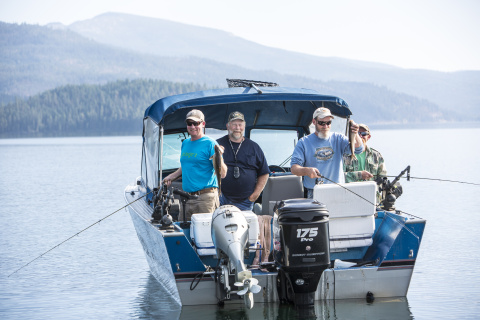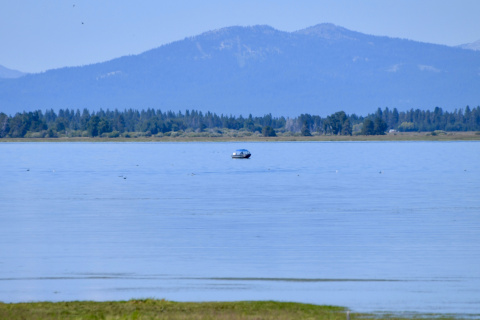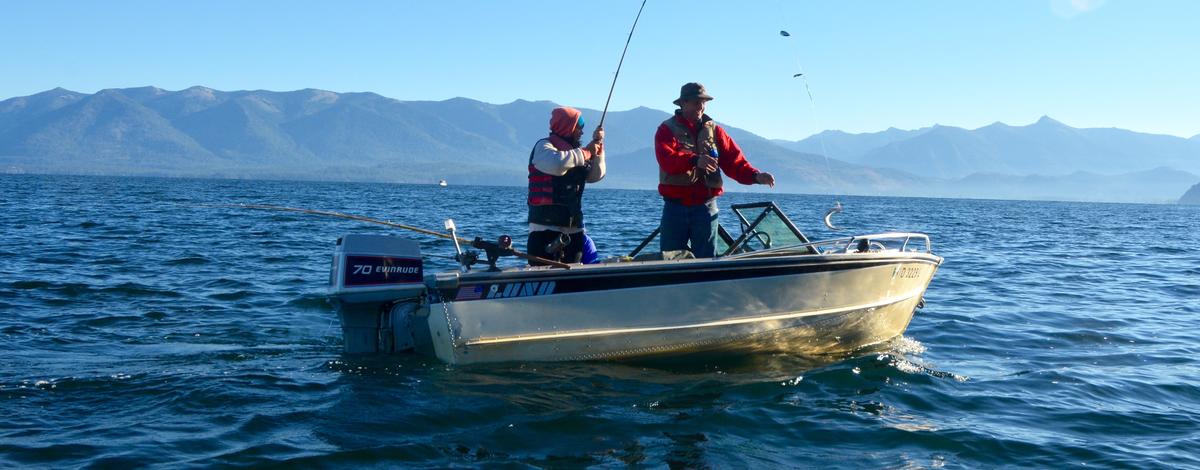Idaho’s “Great Lakes” are not only large in size, but also provide excellent fishing opportunities for trophy-sized fish. In many cases, they offer a user-friendly experience because services and accommodations are typically on the lakes, if not close by. (How many times have you arrived at the fishing dock only to realize you forgot to get worms or sunscreen?)
Some of these bodies of water even offer guided fishing trips and boat rentals for people who don’t have all the equipment they need.
Lakes also offer a serene summer getaway where you can bring the family, cool off and enjoy glistening waters. There are a variety of ways to catch fish – from trolling in open water, casting near the shoreline in a canoe or kayak or casting bait and lures from a dock or from the bank.
Idaho’s Great Lakes can be found all around the state, so whether you want a daytrip, weekend outing or late-summer vacation, there’s likely one fairly close. These lakes and reservoirs are just the tip of the iceberg. There are many other Idaho lakes worthy of your time and fishing efforts, and you can find more information at Idaho Fish and Game’s Fishing Planner.
These 10 lakes and reservoirs are among the biggest and best.

Lake Pend Oreille
Lake Pend Oreille is Idaho’s largest lake and boasts some impressive stats: 43 miles long and 6 miles wide with 111 miles of shoreline, not to mention 1,158 feet at its deepest spot, making it the fifth-deepest lake in the U.S.
And it’s worth mentioning Lake Pend Oreille is the only lake in Idaho so big and deep that it’s being used by the Navy for submarine testing, so if you thought your new LiveScope was state of the art, imagine what’s lurking a thousand feet beneath you.
The core of Lake Pend Oreille’s fishing is its kokanee population, which is thriving after Fish and Game launched one of the largest fishery restoration projects in its history to bring those fish back to abundance. Fish and Game crews surveyed the lake in 2021 and found more kokanee than they’ve seen since the early ‘90s.
That’s great news for kokanee anglers, but many other anglers benefit because kokanee support seven other of the lake’s game fish species, including trophy rainbow trout, bull trout and lake trout. The abundance of kokanee has allowed these larger predatory fish to grow to massive sizes. The lake has produced numerous state and world-record fish, as well as a 31-pound bull trout and a 31 ¾-pound rainbow trout just last year.
The lake also hosts a variety of other gamefish, including cutthroat trout, brown trout, largemouth and smallmouth bass, black crappie, northern pike and walleye.
And if that still doesn’t get you excited, some walleye in the lake have a $1,000 reward on their heads. To find out if you caught one, cut off its head and bring it to a drop-off point. There’s also a $15 reward on lake trout in an effort to keep their populations in check and to help keep kokanee abundant. Learn more about the Lake Pend Oreille Angler Incentive Program.
Lake Pend Oreille is also a full-service lake with many marinas, boat rentals, guides, charters and other services, not to mention a multitude of options for lakeside accommodations, which makes it a popular destination for anglers and vacationers alike.

Coeur d’Alene Lake
Playing second fiddle to the Panhandle’s Lake Pend Oreille is Coeur d’Alene Lake. It still offers size, quality and variety for anglers. While roughly half the size of Lake Pend Oreille at 26 miles long and about 1 to 3 miles wide, it’s Idaho’s second-largest lake (Bear Lake is larger, but divided between Idaho and Utah).
Its native fish include Westslope cutthroat, bull trout and mountain whitefish, but throughout its history, Coeur d’Alene Lake has had many other fish introduced that now provide good-to-excellent fishing opportunities. Game fish include kokanee and Chinook salmon, largemouth and smallmouth bass, northern pike, yellow perch, black crappie, brown and black bullheads and more.
Like its bigger sister to the north, the lake has also produced numerous state-record fish, and while its kokanee and Chinook tend to be its marquee fishing attractions, it has been repeatedly named among the top 100 bass fishing lakes in the U.S. The lake has not only its namesake town on its shoreline, but also several other smaller communities, all of which provide accommodations, guides and services for a fishing destination.

Priest Lake
As if Northern Idaho didn’t have enough to brag about, Priest Lake adds another big lake with postcard scenery and quality fishing. Unlike lakes Coeur d’Alene and Pend Oreille that are located near cities, Priest Lake is more rural and less developed, but still has the all the services you need for a day trip, weekend or extended vacation with campgrounds, resorts, charters, boat rentals, accommodations and more.
Priest Lake is about 19 miles long and about 4 miles wide, but it is different from other big lakes and reservoirs because…technically…it’s two lakes. Priest Lake and Upper Priest Lake are connected by a short, narrow channel that’s passable for most boats. The upper lake has no road access and is mostly undeveloped, but it does feature shoreline campsites.
Priest Lake’s main sport fish are lake trout (also called Mackinaw), cutthroat trout, smallmouth bass and kokanee salmon. Lake trout and smallmouth bass offer the best catch rates. Experienced anglers can routinely catch a bag limit of six lakers that usually run in the 16-to-22 inch range. On occasion, a lucky angler will catch a trophy-sized lake trout weighing 10 to 20 pounds.
The lake’s abundant lake trout population has taken a toll on the kokanee population, so catch rates for kokanee are much lower than in Lake Pend Oreille where the population is much larger. If you’re seeking a more backcountry atmosphere, Upper Priest Lake is an excellent opportunity to find it, but don’t expect to be alone because it’s a popular area for anglers, campers and boaters. The upper lake is a good place to fish for native cutthroat trout and bull trout. Just remember, catch-and-release is required for these species.

Dworshak Reservoir
If you want a big reservoir with lots of elbow room, Dworshak is a great opportunity to find solitude and good fishing. The reservoir is created by Dworshak Dam and creates a backwater on the North Fork of the Clearwater River and several tributaries stretching about 16,500 acres across miles in the heart of the Clearwater backcountry.
Anglers can catch kokanee salmon, trout and smallmouth bass. Dworshak is the current state record holder for smallmouth bass and continues to produce trophy-sized bass.
Most people access the reservoir and launch boats via Dworshak State Park at the reservoir’s south end, near the town of Ahsaka and a few miles west of Orofino. If you’re planning to camp, that’s a good option that will give you easy access to nearby services.
Another option, if you want more seclusion, is boat-in campsites with no road access that are managed by the U.S. Army Corps of Engineers. There are 96 of them located throughout the reservoir, and all are equipped with vault toilets, picnic tables, and fire rings. Use is first-come, first-served, and there are no camping fees.
While the reservoir has dozens of miles of shoreline, its lack of road access means it’s best suited for boaters, not shore anglers, although there are a few places to access it. Services are limited once you’re on the lake, so stock up in nearby communities before you get there.

Lake Cascade
While technically a reservoir, this lake is among the largest in the state at 21-miles long and up to 4.5-miles wide. Despite its size, it’s relatively shallow with a mean depth of 26 feet, but it’s extremely productive and has produced numerous state and world-record fish. Lake Cascade’s perch fishery is a great success story thanks to a multi-year effort by Fish and Game and partners to reduce predatory, nongame fish, transplant perch from other waters and let them naturally spawn and flourish.
While perch may be lake’s current marquee species, it has at least 10 species of game fish and produces lots more trophy fish. Other species include rainbow trout and smallmouth bass, as well as the occasional coho salmon and kokanee.
Lake Cascade is a year-round fishery, and summer is an excellent time to visit because its 4,760-feet elevation means temperatures aren’t too hot and the lake is rimmed by numerous developed campgrounds. Lake Cascade State Park offers shore-side camping around the lake, as well as boat ramps and picnic areas. It’s well-suited for RV camping and fishing with numerous paved RV pads around the lake with nearby boat launches.
Despite its size, Lake Cascade is accessible by a variety of boats. Its three arms in the upper end leading into the main pool means there’s plenty of water accessible with smaller craft, such as a kayaks, canoes and other small craft.
Trolling is a productive way to fish, but because of its relatively shallow nature, bank fishing with bait, or pitching lures, will likely get you into fish. But beware, the lake has a well-earned reputation for being fickle, so don’t be discouraged if you don’t catch fish immediately. It may time some effort to learn how to catch fish at Lake Cascade, but there are lots of fish to be had if you’re patient and persistent.

American Falls Reservoir
This is another Snake River reservoir that doubles as a “Great Lake” because of its large size and trophy fishing opportunities. It’s the largest of Idaho’s Snake River reservoirs, but unlike others that tend to favor warmwater fish, American Falls also supports a trophy trout fishery that includes rainbows, browns and cutthroat trout.
Although it’s a large reservoir at 55,000 acres, its shoreline has a variety of bays, inlets and coves that provide a fishing experience similar to smaller waters, which anglers in small craft can enjoy.
The lake has lots of catchable trout thanks to regular stocking by Fish and Game. About 225,000 trout have already been stocked in 2022, which thrive in the productive waters and grow to large sizes.
The reservoir has a well-deserved reputation for growing large trout, and it has produced several state records over the years. That productivity applies to naturally spawning smallmouth bass, which are plentiful and also grow large, and there’s also yellow perch. The reservoir is often drawn down very low by August, so fishing is best here in spring to mid-summer before the water gets too low.
The town of American Falls is at the southwest end of the reservoir, where there are several boat launches and fuel available. There’s also services and a boat launch available near Aberdeen, midway up the reservoir on the west side. Camping is available at Massacre Rocks State Park, as well as several private RV parks and campgrounds on or near the reservoir.

Bear Lake
Large and unique are two simple words to describe this Southeast Idaho destination. Large is self-explanatory at about 20-miles long and 8-miles wide. The lake is roughly divided in half between Idaho and Utah, and you can fish the entire lake with a license from either state.
The unique part deserves more details. First, it’s clear, aquamarine color has earned it the nickname of “Caribbean of the Rockies” and the lake boasts four “endemic” species of fish, which means they exist nowhere else on earth, such as Bear Lake whitefish, Bonneville cisco, Bonneville whitefish and Bear Lake sculpin.
Anglers are drawn to the lake for its trophy Bonneville cutthroat trout, lake trout and whitefish. There’s also a unique (there’s that word again) cisco fishery where fish are dip-netted through the ice during the fishes’ winter spawning season.
The lake’s size and large fish that favor deeper water mean it’s best fished from a boat, but there are some shore fishing opportunities as well.
The lake is a destination for many people, so there’s plenty of services available, including full-service camping at Bear Lake State Park, various accommodations from motels to vacation rentals, boat and other recreation rentals and more.

Anderson Ranch Reservoir
Anderson Ranch Reservoir is most notably a kokanee fishery; however, anglers can also catch rainbow trout, bull trout, landlocked Chinook salmon, smallmouth bass, yellow perch and the occasional mountain whitefish. Kokanee fishing is best from May to mid-July, while bass start biting best in June. The lake’s higher elevation means the bass fishing comes on a bit later than typical places like Brownlee and CJ Strike.
Anderson Ranch provides ample fishing opportunities for both boaters and shore anglers. There are some campgrounds and dispersed camping sites available, but they will likely be in high demand during the summer camping season, so beware. Supplies are available in the nearby town of Pine.
Folks should be cautious, especially when it's windy. Despite its size, Anderson Ranch Reservoir is still accessible by smaller craft, such as canoes, kayaks and other fishing craft.

Henrys Lake
Henrys Lake is smaller than most of its fellow great lakes, but is still a respectable size at about 8 square miles and at about 6,500-feet elevation with the panoramic peaks of the Centennial Mountains and Henrys Lake Range provide a breathtaking backdrop. Let’s call it the ‘Grand Daddy’ of mountain lakes.
Equally breathtaking are the trophy fish the lake produces. Henrys Lake is a destination for anglers trying (and often succeeding) to catch its large Yellowstone cutthroat trout, sterile rainbow/cutthroat hybrids and sterile brook trout. Sterile trout varieties are stocked to prevent interbreeding with the lake’s native cutthroat trout, and they can achieve some remarkable sizes as a result of their long life spans. Henrys Lake produced the state-record brook trout, an 8-pound behemoth by brookie (or any other trout’s) standards. Cutthroats and hybrids semi-regularly top the 10-pound mark, and 20-inchers are so common they barely raise an eyebrow, unless of course, one is on the end of your line.
Fish and Game stocks 750,000 to 1.3 million young trout each fall, most of which are taken from spawners returning to a hatchery on the lake, which ensures a steady supply of big fish from this productive lake.
Due to its high elevation, Henrys has a fairly short fishing season for open water (non-ice) and summer and early fall are both prime times for anglers. Aquatic vegetation tends to grow along the shoreline during summer, so bank angling can be challenging depending on your location. Despite its high elevation, the lake can warm during summer, which tends to drive fish into deeper water in the middle of the lake.
Camping is available at Henrys Lake State Park, and at other developed and dispersed camping areas on public land managed by the Forest Service and Bureau of Land Management. There are various other accommodations around the lake, as well as in the nearby communities of Island Park and Mack’s Inn.

C.J. Strike Reservoir
This is another bountiful reservoir created by a dam on the Snake River in southern Idaho. But C.J. Strike is a little different than the others because C.J. Strike Reservoir is a “run of the river” facility, so its water levels remain relatively constant. Why is that important? Because it provides a year-round, full pool for anglers and a very productive place to grow fish.
Like other Snake River reservoirs in Southern Idaho, warmwater fish are its main attraction, but there are some trout as well. Smallmouth bass, largemouth bass, perch and crappie are among the most common species caught in C.J. Strike, but you can also catch bluegill, sturgeon, channel catfish and bullheads, as well as a variety of nongame fish.
For anglers seeking Idaho’s largest game fish, sturgeon up to 9-feet long are abundant in the reservoir, but no harvest is allowed. For those without a boat, the park below C.J. Strike Dam is a prime sturgeon fishing hole for shore anglers. Bring your heaviest rod and tackle.
While boats have a clear advantage for reaching prime fishing spots, most of the south shoreline of the reservoir is accessible by roads and offers lots of place for those without a boat to catch fish. It’s also mostly friendly to small, human-powered boats, such as kayaks, canoe and small pontoon boats, but beware the reservoir can get windy and choppy, especially in the afternoons.
The reservoir has several developed campgrounds on the south shoreline, and ample places for dispersed/undeveloped camping. You can find supplies at each end of the reservoir in the small communities of Grandview and Bruneau.
Find more lakes and reservoirs
To learn more about places to fish in Idaho and where fish have recently been stocked, see the Fishing Planner and the Fish Stocking webpages.

